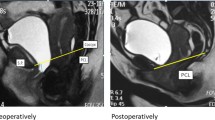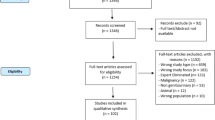Abstract
Purpose
We prospectively evaluated changes in morphology and dynamics of the male pelvic floor on magnetic resonance imaging (MRI) associated with retrourethral transobturator sling (RTS) placement.
Patients and methods
Twenty-six men with post-prostatectomy incontinence consecutively underwent functional cine-MRI before and 12 months after RTS. The membranous urethra length (MUL) and severity of periurethral/urethral fibrosis were assessed on static MRI. A lowering of the posterior bladder wall (BPW), the bladder neck (BN), the external urinary sphincter (EUS) and symphysial rotation of these structures were analysed on dynamic MR images. The success rate was defined as cure (0–1 dry ‘security’ pad) or improvement (pad reduction ≥50 %).
Results
The success rate was 77 % (20/26 patients). The mean follow-up was 20.4 months. The MUL significantly increased post-operatively (p < 0.001). There were no significant pre- and post-operative differences in severity of periurethral/urethral fibrosis. Significant elevation of the BPW (p < 0.021), BN and EUS (p < 0.002) was observed post-operatively. The RTS failure was significantly associated with the severity of periurethral fibrosis pre- (p < 0.032) and post-operatively (p < 0.003).
Conclusions
RTS placement is associated with MUL increase, elevation of the BN, BPW and EUS. De novo development of periurethral or urethral fibrosis seems not to be confirmed. The RTS failure was related to the severity of pre- and post-operative periurethral fibrosis. The impact of MRI on pre-operative diagnostics of RTS failure needs further evaluation.






Similar content being viewed by others
References
Bauer RM, Gozzi C, Hübner W et al (2011) Contemporary management of postprostatectomy incontinence. Eur Urol 59:985–996
Rehder P, Gozzi C (2007) Transobturator sling suspension for male urinary incontinence including post-radical prostatectomy. Eur Urol 52:866–867
Davies TO, Bepple JL, McCammon KA (2009) Urodynamic changes and initial results of the AdVance male sling. Urology 74:354–357
Rehder P, Mitterberger MJ, Pichler R et al (2010) The 1 year outcome of the transobturator retroluminal repositioning sling in the treatment of male stress urinary incontinence. BJU Int 106:1668–1672
Soljanik I, Becker AJ, Stief CG et al (2011) Urodynamic parameters after retrourethral transobturator male sling and their influence on outcome. Urology 78:708–712
Bauer RM, Mayer ME, Gratzke C et al (2009) Prospective evaluation of the functional sling suspension for male postprostatectomy stress urinary incontinence: results after 1 year. Eur Urol 56:928–933
Cornu JN, Sèbe P, Ciofu C et al (2010) Mid-term evaluation of the transobturator male sling for post-prostatectomy incontinence: focus on prognostic factors. BJU Int 108:236–240
De Ridder D, Rehder P (2011) The AdVance male sling: anatomic features in relation to mode of action. Eur Urol Suppl 10:383–389
Rehder P, von Gleissenthall GF, Pichler R et al (2009) The treatment of postprostatectomy incontinence with the retroluminal transobturator repositioning sling (Advance®): lessons learnt from accumulative experience. Arch Esp Urol 62:860–870
Soljanik I, Gozzi C, Becker A et al (2011) Risk factors of treatment failure after retrourethral transobturator male sling. World J Urol. doi:10.1007/s00345-011-0671-6
Myers RP, Cahill DR, Devine RM et al (1998) Anatomy of radical prostatectomy as defined by magnetic resonance imaging. J Urol 159:2148–2158
Song C, Doo CK, Hong JH et al (2007) Relationship between the integrity of the pelvic floor muscles and early recovery of continence after radical prostatectomy. J Urol 178:208–211
Allen SD, Thompson A, Sohaib SA (2008) The normal post-surgical anatomy of the male pelvis following radical prostatectomy as assessed by magnetic resonance imaging. Eur Radiol 18:1281–1291
Paparel P, Akin O, Sandhu JS et al (2009) Recovery of urinary continence after radical prostatectomy: association with urethral length and urethral fibrosis measured by preoperative and postoperative endorectal magnetic resonance imaging. Eur Urol 55:629–639
Bauer RM, Mayer ME, May F et al (2010) Complications of the AdVance transobturator male sling in the treatment of male stress urinary incontinence. Urology 75:1494–1498
Abrams P, Cardozo L, Fall M et al (2003) The standardisation of terminology in lower urinary tract function: report from the standardisation sub-committee of the International Continence Society. Urology 61:37–49
Soljanik I, Becker A, Stief CG et al (2010) Repeat retrourethral transobturator sling in the management of recurrent postprostatectomy stress urinary incontinence after failed first male sling. Eur Urol 58:767–772
Lienemann A, Sprenger D, Janssen U et al (2004) Assessment of pelvic organ descent by use of functional cine-MRI: which reference line should be used? Neurourol Urodyn 23:33–37
Loughlin KR, Prasad MM (2010) Post-prostatectomy urinary incontinence: a confluence of 3 factors. J Urol 183:871–877
Lee SE, Byun SS, Lee HJ et al (2006) Impact of variations in prostatic apex shape on early recovery of urinary continence after radical retropubic prostatectomy. Urology 68:137–141
Van Randenborgh H, Paul R, Kubler H et al (2004) Improved urinary continence after radical retropubic prostatectomy with preparation of a long, partially intraprostatic portion of the membranous urethra: an analysis of 1013 consecutive cases. Prostate Cancer Prostatic Dis 7:253–257
Hammerer P, Huland H (1997) Urodynamic evaluation of changes in urinary control after radical retropubic prostatectomy. J Urol 157:233–236
Kielb SJ, Clemens JQ (2005) Comprehensive urodynamics evaluation of 146 men with incontinence after radical prostatectomy. Urology 66:392–396
Constantinou CE, Freiha FS (1992) Impact of radical prostatectomy on the characteristics of bladder and urethra. J Urol 148:1215–1219
Coakley FV, Eberhardt S (2002) KattanMW, et al. Urinary continence after radical retropubic prostatectomy: relationship with membranous urethral length on preoperative endorectal magnetic resonance imaging. J Urol 168:1032–1035
Kordan Y, Alkibay T, Sozen S et al (2007) Is there an impact of postoperative urethral and periurethral anatomical features in post-radical retropubic prostatectomy incontinence? Urol Int 78:208–213
Steiner MS (1994) The puboprostatic ligament and the male urethral suspensory mechanism: an anatomic study. Urology 44:530
Tuygun C, Imamoglu A, Keyik B et al (2006) Significance of fibrosis around and/or at external urinary sphincter on pelvic magnetic resonance imaging in patients with postprostatectomy incontinence. Urology 68:1308–1312
Acknowledgments
The author would like to thank Dr. Karin Herrmann for providing support in choice of MR-parameters and facilitate the MR-examinations. The study has not been financial supported.
Conflict of interest
Christian Gozzi holds the intellectual property as a co-inventor of the procedure. Christian Gozzi declares consultancy work, lectures, and participation in clinical trials for AMS. Ricarda M. Bauer declares lectures for AMS and participation in clinical trials. All authors declare that no funding or other agreement has limited their ability to fairly complete and publish this data and they had full control of the primary data. There has been no extra-institutional funding for this study.
Author information
Authors and Affiliations
Corresponding author
Rights and permissions
About this article
Cite this article
Soljanik, I., Bauer, R.M., Becker, A.J. et al. Morphology and dynamics of the male pelvic floor before and after retrourethral transobturator sling placement: first insight using MRI. World J Urol 31, 629–638 (2013). https://doi.org/10.1007/s00345-012-0884-3
Received:
Accepted:
Published:
Issue Date:
DOI: https://doi.org/10.1007/s00345-012-0884-3




